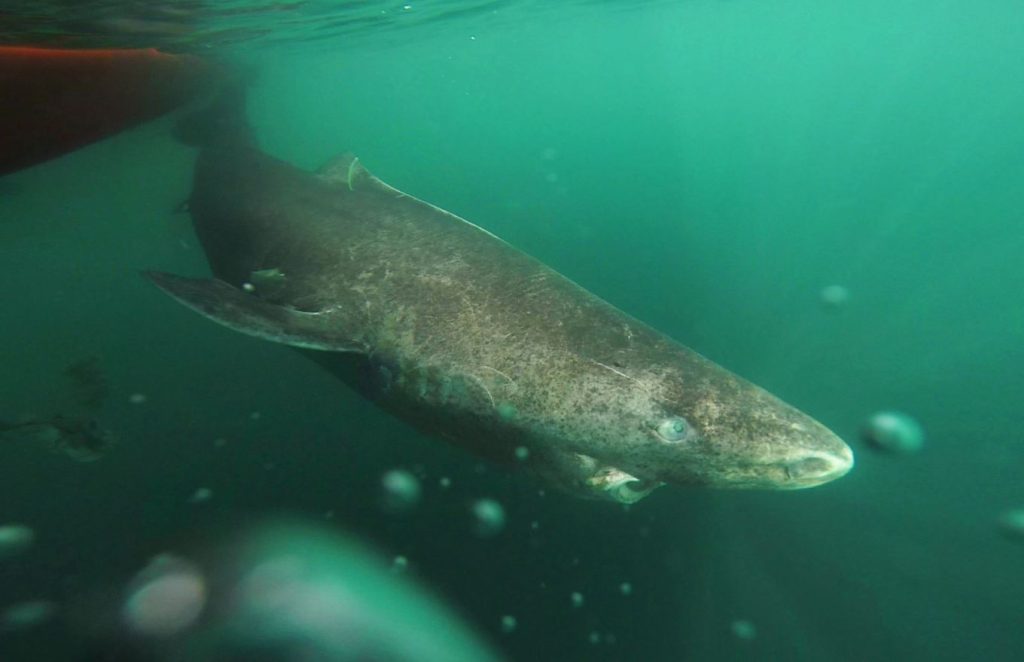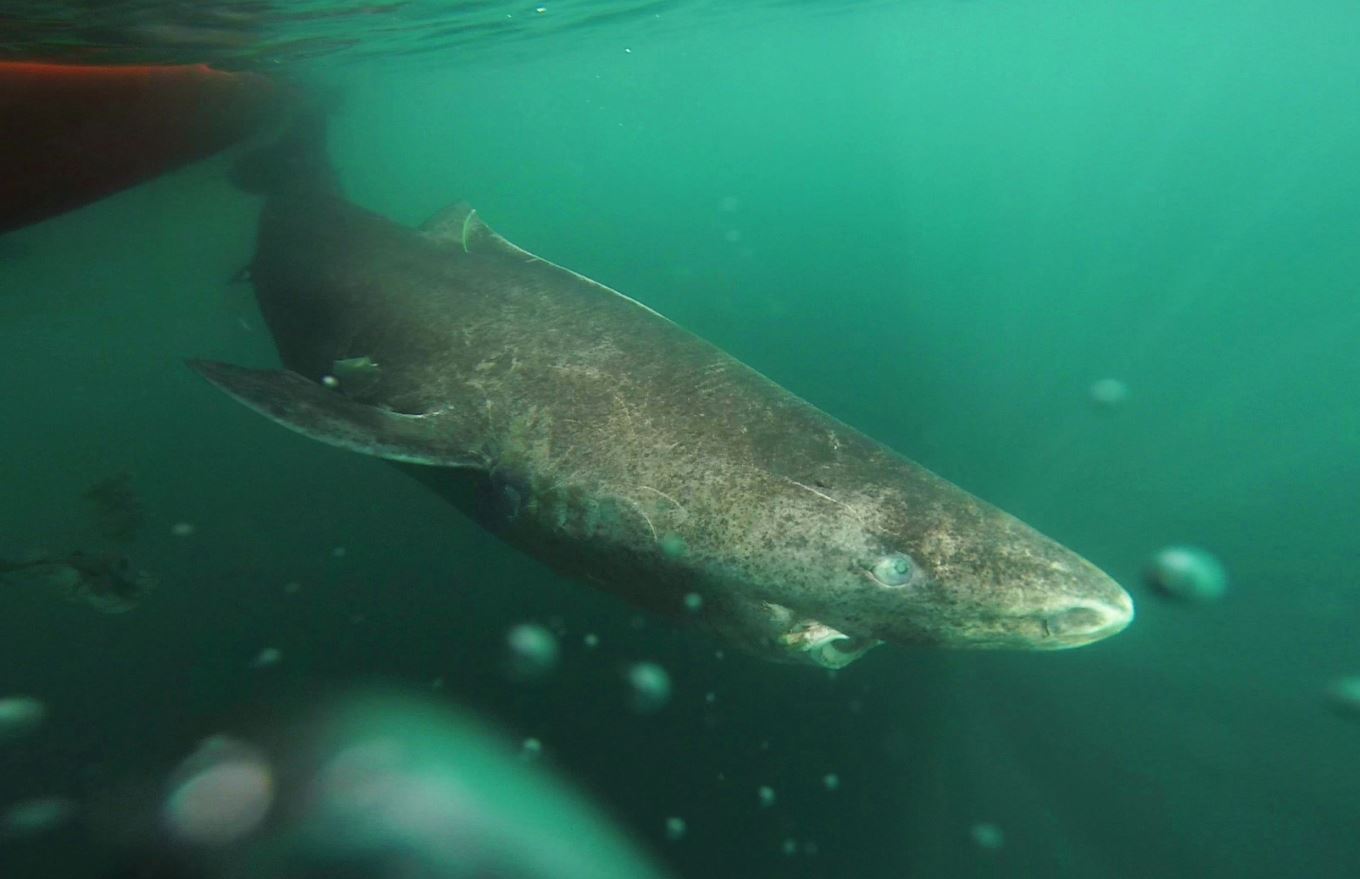Step into the enigmatic underwater world of the Greenland shark with our comprehensive guide, filled with intriguing facts, visuals, and videos…
The elusive Greenland shark resides in the chilly waters of the sub-Arctic and holds secrets that still puzzle scientists today. They are one of the rare species that inhabit these northern regions throughout the year.
Greenland Shark Overview: Scientific Name & Classification

Like all other sharks, Greenland sharks fall under the Elasmobranchii subclass, commonly known as cartilaginous fish. This subclass also embraces skates and rays. These species possess a skeletal system made of cartilage, which is more flexible than bone.
(The other primary group of fish is the Osteichthyes, or bony fish subclass.)
Greenland Sharks, within the cartilaginous fish group, are part of the Squaliformes order. Fish in this group are recognized by their twin dorsal fins (fins on their backs) and the absence of an anal fin (a fin located on the underside of a fish, close to the tail).
Lastly, Greenland Sharks are categorized into the Somniosidae family, also known as the sleeper shark family. This family comprises 20 species, many of which are not well-studied due to their deep-sea living conditions.
The scientific name assigned to the Greenland shark is Somniosus microcephalus.
What Does A Greenland Shark Look Like?
Greenland sharks are large, growing up to 21ft (6.4m) in length, which is comparable to the Great White Sharks. These creatures experience significant growth since they are born merely 15 inches (38 cm) long!
Greenland Sharks can weigh up to 2,000 lb (900 kg).
Individual Greenland sharks exhibit diverse coloration, ranging from brown and dark grey to black, occasionally punctuated with white spots.
A Greenland Shark’s eyes are small compared to its body size, and it features a blunt snout. Its dorsal and pectoral fins are small.
Similar to most sharks, the Greenland Shark has rows of teeth that continuously regenerate throughout the animal’s lifetime. These teeth are anchored in the upper and lower jaw muscles (not bone).
Below is some impressive footage of a Greenland Shark:
Greenland Shark Adaptations
The Greenland shark exhibits several adaptations typical to all shark species. Its cartilaginous skeleton provides flexibility and lightness, facilitating buoyancy. Unlike ordinary fish, sharks do not possess a swim bladder but have a large liver filled with oil which contributes up to 30% of their body mass. This aids in buoyancy, yet it also attracts hunters who seek the oil.
To extract oxygen, sharks need constant water flow over their five sets of gills located on either side of the head. Hence, they swim incessantly in a process known as ram ventilation. Unlike fish, a shark’s gills are exposed.
In the dark, murky underwater environment, a keen sense of smell is crucial, and the Greenland shark has mastered this particular skill, given their limited vision due to small eyes.
In some instances, Greenland Sharks can completely lose their sight following attacks by parasites such as the copepod (a small crustacean) Ommatokoita elongate. This tiny creature latches onto the shark’s eye, leading to lesions that ultimately cause blindness.
The Greenland shark has teeth anchored in its upper and lower jaw muscles. The top ones are pointed for gripping while the bottom ones are serrated for tearing and ripping.
Greenland sharks, known as the most northern sharks, inhabit incredibly cold waters and withstand winter temperatures as low as 28°F (-2°C). To thrive in these harsh conditions, the Greenland shark possesses a unique adaptation: a natural equivalent to antifreeze in its flesh.
Trimethylamine oxide (TMAO) aids by stabilizing enzymes and proteins in the shark’s body against the cold. Interestingly, this TMAO also renders the Greenland Shark’s flesh toxic to mammals.
However, this special adaptation slows down the usual biochemical processes happening within the shark. These processes occur so slowly that the Greenland shark is estimated to grow a mere 0.25 inches (0.56cm) per year.
Reproduction
The Greenland shark exhibits a reproductive strategy known as ovoviviparity, where the female’s eggs hatch inside her body, leading to the birth of live, fully formed young.
The exact gestation period (the time taken for the unborn sharks to develop) remains unknown, but it’s thought that approximately 10 young are born each cycle. Owing to the scarcity of scientific research on the species, the specifics of reproduction timing or location remain a mystery.
How Long Do Greenland Sharks Live?
Greenland Sharks are speculated to live up to 200 years, although this is a calculation based on current data (essentially an educated guess!).
Greenland Shark Habitat: Where Do Greenland Sharks Reside?
Greenland Sharks are a deep-water species, inhabiting exclusively the cold Arctic and sub-Arctic seas. They are commonly found in the waters surrounding Canada, Greenland, Norway, and Iceland.
They prefer deeper waters during the summer and have been recorded at a maximum depth of 7200ft, though they usually dwell between 600 and 2400ft.
In the winter, they inhabit shallower regions and are frequently observed near the ice edges.
Greenland Shark Diet
Like most sharks, the Greenland shark will consume whatever it can get its teeth on! It is presumed to be both a predator and a scavenger.
Post-mortem examinations have revealed a wide variety of species in a Greenland Shark’s stomach contents. Besides skates, teleost fishes, and carrion, seals, birds, caribou, and even a polar bear skull have been discovered!
Greenland Shark Behavior
Greenland sharks appear to be slow and sluggish, considered to be among the slowest swimming sharks.
While much of the shark’s behavior remains unknown, biologists were astonished to observe them attacking Caribou swimming across estuaries. It is yet unclear if the sharks exhibit this behavior towards other species like seals, but it is rather surprising given their physique.
Greenland Shark Threats
The primary threat to Greenland sharks has been commercial hunting, with Norway and Greenland often capturing up to 30,000 sharks annually. Greenland sharks are targeted for their sizeable livers, which serve as a source of lubricant.
Another significant threat is bycatch, where the sharks are accidentally ensnared by trawlers, trap fisheries, and gillnets.
The slow reproductive rate of this species exacerbates these issues, as the sharks are incapable of replenishing their population swiftly.
Are Greenland Sharks Endangered?
Although precise population numbers are not known, the IUCN has classified the Greenland Shark as ‘near threatened’ due to their slow reproductive rate.
Did You Know?
When Inuit hunters capture Greenland sharks, they abstain from feeding the raw meat to their dogs because the toxin in the flesh can debilitate the animals. However, in Iceland, Greenland shark is a traditional dish. The meat is typically hung for several months until the toxins are neutralized.
Greenland Shark Highlights
- Greenland sharks are massive, reaching an impressive length of up to 21ft (6.4 metres)!
- Their coloration can vary from brown and grey to black.
- Among all shark species, they are recognized for their slow swimming speed.
- Their flesh contains toxic chemicals, aiding their survival in icy seas.
- With relatively small eyes, Greenland sharks are often blind due to damage inflicted by a copepod parasite.
- The Greenland shark is not only long-lived but also grows slowly; potentially only gaining 1/4 inch per year.
- Greenland sharks hold the title of being the most permanently northern of sharks, persisting in the Arctic and sub-Arctic waters throughout the year.
- Their diet is extremely diverse, with one even found with a polar bear skull in its stomach!
- The behavior of these sharks remains largely mysterious, due to difficulties in studying and infrequent filming of these creatures.
- Overhunting poses a significant threat. Bycatch from commercial fishing, coupled with slow reproduction and growth, further exacerbates the problem.
- Greenland Sharks are rated as ‘Near Threatened’ on the IUCN Red List.
- Fermented Greenland shark meat, despite its toxic raw state, is considered a national delicacy in Iceland.
